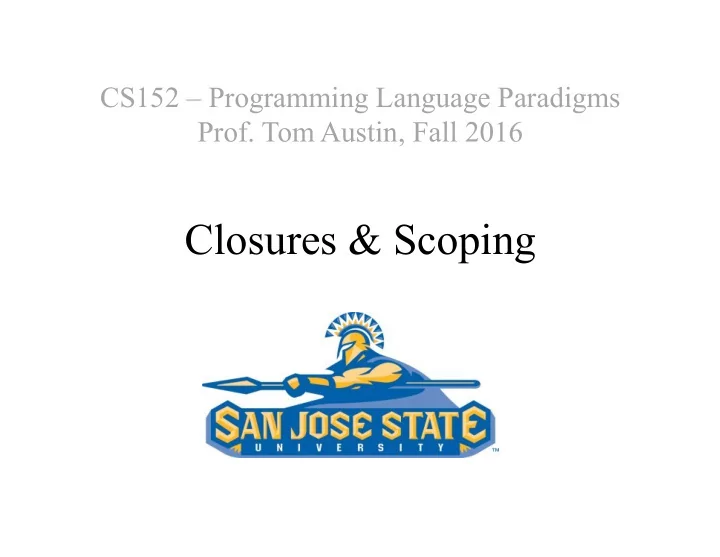

CS152 – Programming Language Paradigms Prof. Tom Austin, Fall 2016 Closures & Scoping
Variables • Parameters • Local variables • Free variables – Variables not defined in the current scope – e.g. global variables
#!/bin/bash Is x 42? x=42 function foo { x is a free echo $x variable } function bar { local x=666 Or is x 666? foo } bar
Lab part 1 • Guess what the bash script should print • Run the script • Rewrite the script into a Java program as faithfully as you can. What does it return?
#!/bin/bash Most languages uses static or lexical scoping, so x x=42 would be 42. function foo { echo $x } But Bash uses dynamic scoping, so x is 666? function bar { local x=666 foo } bar
Scoping definitions • In static or lexical scoping, name resolution depends on where the named variable is defined. • In dynamic scoping, name resolution depends on the execution path of the code (the calling context).
Why do some languages use dynamic scoping?
Closures and Environments • A closure is a pair of – a function, and – its environment • An environment is a mapping of free variables to their values defined outside the function.
Simple example of closures (define (make-adder x) (lambda (y) (+ x y))) (let ([add-two (make-adder 2)]) (add-two 3))
(define (make-counter) (let ([count 0]) (lambda () ( set! count (+ count 1)) count))) (define my-count (make-counter)) (my-count) (my-count) (define ctr2 (make-counter)) (ctr2) (my-count)
(define (box x) (cons ( λ () x) ( λ (y) ( set! x y)))) (define (get-val bx) ((car bx))) (define (set-val! bx new-val) ((cdr bx) new-val))
Using box (let ([my-box (box 3)]) (displayln (get-val my-box)) (set-val! my-box 4) (displayln (get-val my-box)))
Lab, part 2 • Use box to create an Employee object. • Details in Canvas.
Recommend
More recommend